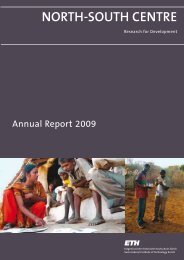Annual Report 2006/07 - ETH - North-South Centre North-South ...
Annual Report 2006/07 - ETH - North-South Centre North-South ...
Annual Report 2006/07 - ETH - North-South Centre North-South ...
Create successful ePaper yourself
Turn your PDF publications into a flip-book with our unique Google optimized e-Paper software.
Impact Study18market opportunities and in productivity of their herds whileincreasing the pressure on the scarce natural resources, whichcontributes further to environmental degradation.In order to support poor livestock-keeping households in seizingthe opportunities of the Livestock Revolution, or at least in mitigatingits negative consequences, complementary approachesare necessary, such as reforms in policy and governance, technicaldevelopment programmes and pro-poor research.ZIL’s contribution to improving the livelihood of livestocksmallholdersZIL’s research programme tackled essential topics concerninglivestock in a context of poverty and vulnerability, dealingwith• improved feeds: low-cost high-quality animal nutrition;• improved breeds: disease-resistant, productive andculturally acceptable breeds;• improved policies: understanding the systems toovercome weaknesses in the supply chain in a context oftransition and conflict;• improved nutrition: reducing protein and micronutrientdeficiency;and, beside the livestock-focussed projects,• improved food security: reducing post-harvest and yieldlosses in beans and cassava.The various scientific results obtained are not only valuable forbeing published and made accessible to the community of scientificpeers; they also provide concrete positive solutions forpoor households keeping livestock in terms of increased incomesecurity, reduced vulnerability and emerging well-being.For example, the new screening methodology developed inthe project on low phosphorus tolerance in Brachiaria grasseswas adopted by CIAT, who cooperates with researchers of aninternational seed company to further improve the Brachiariahybrids and later disseminate them in Latin America, Africaand Asia.Similarly, the final results of the long-term research on thecombination of optimised natural resources for the safe storageand food processing of beans pursued at the <strong>ETH</strong> Zurichled to the crossing of the storage protein arcelin in every newbean line by CIAT (the worldwide mandate holder on beans).Either result-oriented through new knowledge and technologiesor process-oriented through capacity development, theZIL projects allow the suggesting of well-founded, viable andsustainable options for policy-makers to reduce the negativeconsequences of global changes in the livestock sector for thepoor, such as in the project on the relationship between livestock-keepingand the diet of young children in Ethiopia: ILRI,a partner of ZIL, is drafting practical recommendations for therelevant ministries to improve their nutrition campaigns andmessages conceerning nutritional security, substantiated onthe new findings of the abovementioned ZIL project.Targeting the final beneficiaries, these projects help identifyopportunities for smallholders to maintain, respectivelyupgrade, their livestock assets and to access the supply chain.As a consequence of the qualitative and quantitative improvementsdemonstrated in the scientific trials on dry-seasonfeeding systems, dairy cattle smallholders in Nicaraguaformed an association to qualify for government credit withthe purpose of extending their forage-planted surfaces.In Côte d’Ivoire, young livestock-keepers from the <strong>North</strong>ernregion formed an association in order to profit from theopportunities identified in the socio-economic analysis of theprevailing livestock systems.In terms of academic capacity development, twelve doctoraldegrees (six of them by women and five by students from
















